
The U.S. Patent and Trademark Office recently released its Performance and Accountability Report for Fiscal 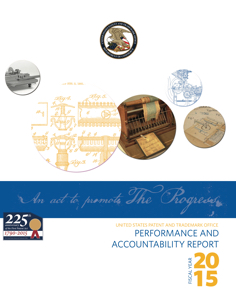 Year (FY) 2015. In describing the USPTO's strategic and performance-planning framework, the 2015 report begins by reminding readers that the Office issued a new strategic plan in 2014, the 2014-2018 Strategic Plan. The report indicates that the 2014-2018 Strategic Plan "demonstrates the progress made to date by building on the tangible successes of recent years with a focus on achieving the USPTO's vision as a global IP leader by:
Year (FY) 2015. In describing the USPTO's strategic and performance-planning framework, the 2015 report begins by reminding readers that the Office issued a new strategic plan in 2014, the 2014-2018 Strategic Plan. The report indicates that the 2014-2018 Strategic Plan "demonstrates the progress made to date by building on the tangible successes of recent years with a focus on achieving the USPTO's vision as a global IP leader by:
• Establishing the optimal pendency and quality levels for both patents and trademarks that will enable the USPTO to operate efficiently and effectively within the expectations of the IP community;
• Administering effectively the provisions of the AIA;
• Continuing to transform the USPTO with next-generation technology and services;
• Maintaining a strong and diverse leadership team, agile management structure, and a diverse and engaged cadre of employees in achieving the agency's mission and vision;
• Continuing to work with other government agencies, Congress, and USPTO's global partners to establish IP systems that benefit innovation, create jobs, and lead to strong economies around the world; and
• Recruiting and retaining the highest quality employees to accomplish the agency's important work."
As in the previous 2010-2015 Strategic Plan, the Office's 2014-2018 Strategic Plan sets forth three strategic goals and one management goal in support of the Office's mission to foster innovation, competitiveness and economic growth, domestically and abroad by delivering high quality and timely examination of patent and trademark applications, guiding domestic and international intellectual property policy, and delivering intellectual property information and education worldwide, with a highly-skilled, diverse workforce.
The 2014-2018 Strategic Plan specifies eleven performance outcome measures for which the Office has developed annual performance targets. According to the report, the Office met its annual performance targets for eight of the eleven performance targets (as the Office did in FY 2014). Unfortunately, two of the three targets that were missed fell within the first strategic goal, which concerns optimizing patent quality and timeliness. In particular, average first action pendency was 17.3 months (higher than the 16.4-month target, but lower than the 18.4-month average first action pendency of FY 2014), and patent quality composite score was 42.9 (lower than the 83 to 91 target and lower than the 75.0 patent quality composite score of FY 2014). Average total pendency, however, was 26.6 months (lower than the 27.7 month target and lower than the 27.4 month average total pendency of FY 2014).
The patent quality composite score performance target was new to the 2014 report, replacing the percent of patent applications that were filed electronically (in the 2013 report, the Office noted that 98.1% of patent applications were filed electronically, which left little room for improvement). The 2014 report noted that the Patent Quality Composite Score is a quality metric comprising seven individual quality metrics that were developed in conjunction with external stakeholders. In particular, the 2014 report explained that the seven factors measure:
(a) the quality of the action setting forth the final disposition of the application; (b) the quality of the actions taken during the course of the examination; (c) the perceived quality of the patent process as measured through external quality surveys of applicants and practitioners; (d) the quality of the examiner’s initial search; (e) the degree to which the first action on the merits follows best examination practices; (f) the degree to which global USPTO data are indicative of compact, robust prosecution; and (g) the degree to which patent prosecution quality is reflected in the perceptions of the examination corps as measured by internal quality surveys.
Table 2 of the report provides data for the patent-related performance targets for FY 2011 to FY 2015 (click on any table to expand):

The report also presents data for the following patent-related performance targets: patent average first action pendency for FY 2010 to FY 2015 (upper graph) and patent average total pendency for FY 2010 to FY 2015 (lower graph).
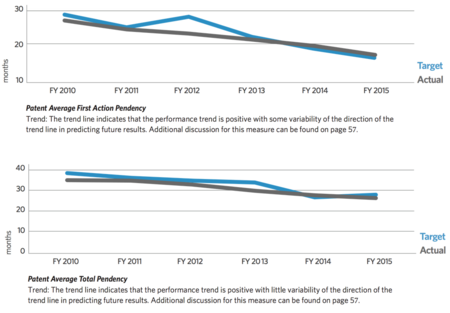
As for the third patent performance target, the report notes that:
The USPTO is working with internal and external stakeholders to reevaluate the entire quality process at the USPTO by engaging in public forums and roundtables to increase the effectiveness, clarity, and simplicity of the USPTO's quality review process by focusing on excellence in work products, excellence in measuring patent quality, and excellence in customer service. As part of this effort, the USPTO aims to define and introduce revised quality metrics based on stakeholder input by September 2017. Because the precise contours of the metric will likely change in the upcoming years, it is not useful to portray trends for the current measure.
The report also notes that the number of applications filed increased from 618,457 in FY 2014 to 617,216 in FY 2015, which constituted a 0.2% decrease in filings (see Table 1 below). This followed a 6.3% increase in application filings in FY 2013 and a 2.8% increase in application filings in FY 2014.
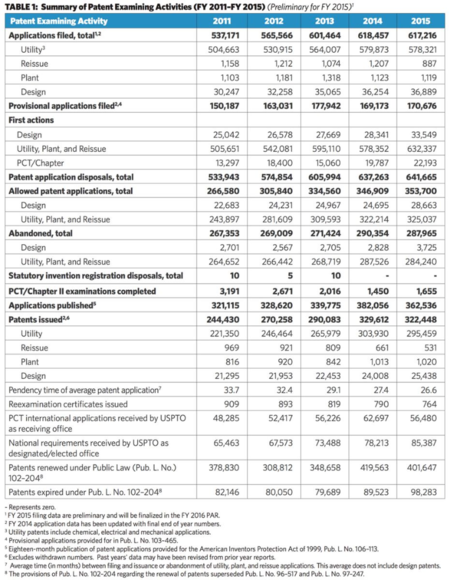
The report also indicates that while the Office accepted more than 600,000 patent applications for the third straight year and topped 500,000 applications for the sixth consecutive year (see Table 2 below), it was able to reduce the number of applications awaiting action from 642,949 in FY 2014 to 592,417 in FY 2015 (see Table 3 below). The total number of pending applications also decreased from 1,127,701 in FY 2014 to 1,099,468 in FY 2015.
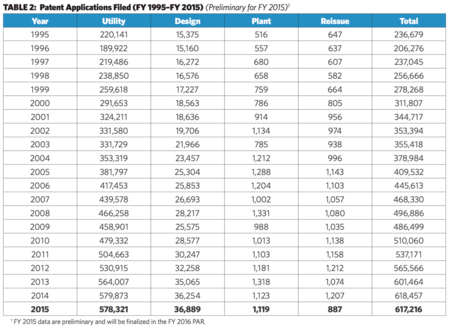
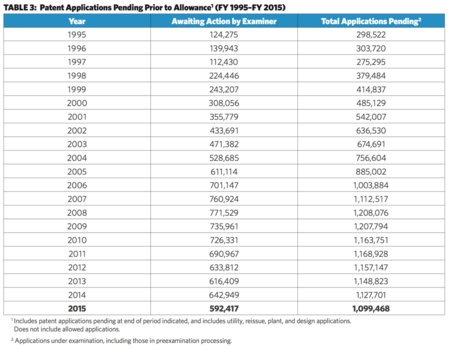
Stopping a seven-year trend, utility patent issuances were down in FY 2015, dropping from 303,930 in FY 2014 to 295,459 in FY 2015 (see Table 6 below).
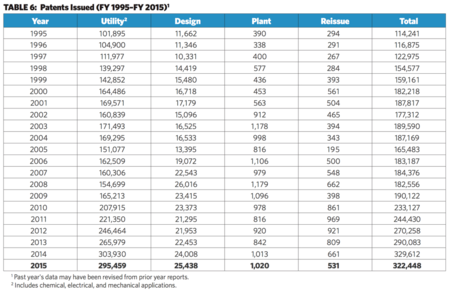
As noted above, the results for first action and total pendency were mixed, with first action pendency coming in above the Office's target, and total pendency coming in below the Office's target (see Tables 4 and 5 below). And the goals for FY 2016 and FY 2017 present even tougher challenges: for first action pendency, the annual performance target drops from 16.4 months for FY 2015 (which the Office failed to meet) to 14.7 months for FY 2016 and 13.2 months for FY 2017, and for total pendency, the annual performance target drops from 27.7 months in FY 2015 (which the Office met) to 23.9 months in FY 2016 and 22.6 months in FY 2017.
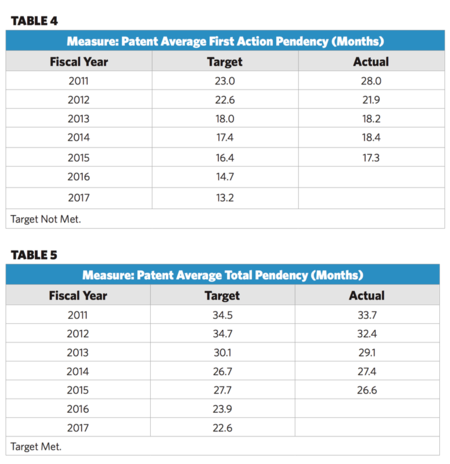
When comparing pendency statistics by Technology Center, Tech Center 1600 (biotechnology and organic chemistry) produced the best average first action pendency (14.1 months) and Tech Center 2100 (computer architecture, software, and information security) produced the worst average first action pendency (20.5 months) (see Table 4 below). As for total average pendency, both Tech Center 1600 and Tech Center 2800 (semiconductor, electrical, optical systems, and components) produced the best numbers (25.3 months), and Tech Center 2100 the worst (31.1 months).
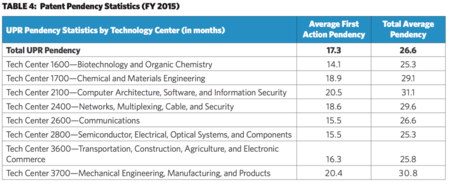
Finally, the report indicates that 1,737 inter partes review cases were filed in FY 2015, up from 1,310 in FY 2014, and 11 post grant review cases were filed in FY 2015, up from 2 in FY 2014 (see Table 15 below).
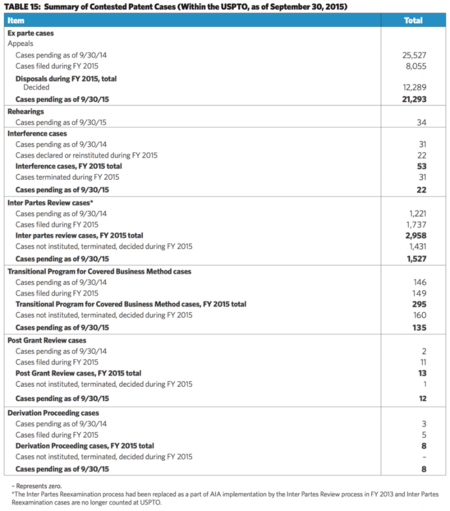
For additional information regarding this and other related topics, please see:
• "USPTO Issues Performance and Accountability Report for FY 2014," April 7, 2015
• "USPTO Releases Performance and Accountability Report for FY 2013," January 9, 2014
• "USPTO Releases Performance and Accountability Report for FY 2012," November 28, 2012
• "USPTO Releases Performance and Accountability Report for FY 2011," November 30, 2011
• "USPTO Releases 2010 Performance and Accountability Report," November 17, 2010
• "USPTO Announces 'Highest Performance Levels in Agency's History' in 2008," November 18, 2008
• "USPTO Announces 'Record Breaking' 2007 Performance," November 15, 2007
• "Patent Office Announces Record-Breaking Year," December 27, 2006